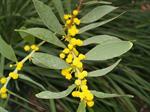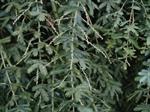Learn about the care of Acacias, and how they are commercially grown and used
-

Learn about the physiology, botany, culture, and propagation of Acacias.
- Learn about their nutritional and environmental requirements, as well as potential disease and pest issues.
- Learn about the wide range of commercial uses for Acacias - the food industry, in perfumes, medicine, furntiture, as well as being used in land rehabilitation projects.
Acacias occur naturally in Australia Africa, the Middle East and across parts of Asia. They include some very hardy species, some able to grow in desert like conditions, and others that are tolerant to severe frost and snow.
Being legumes; they are useful for land rehabilitation; fast growing and able to contribute to improving soil fertility. They include commercially important plants - grown for wood, producing gum arabic, and even edible seeds.
Acacias are also commonly known by the following names:
- Thorntrees,
- Wattles,
- Whistling thorns.
COURSE STRUCTURE AND CONTENT
Course Duration: 100 hours.
Start Date: Start at any time - study at a pace that suits you, and with full tutor support for the duration of your studies.
Lessons: The course comprises 8 lessons as detailed, below.
1. Introduction and Resources
- Nature and Scope of Acacias.
- Plant/Acacia Taxonomy (classification and naming).
- Acacia Ecosystems.
- Significant Acacias from Australia, Africa and the Middle East.
2. Physiology and Botany of Acacias
- Acacia relatives; and the Order Fabales.
- Understanding flower structure of Acacias.
- An inflorescence.
- Using Botanical terms to describe Acacias.
- Acacia foliage.
- Classifying Acacias according to foliage type.
- Classifying Acacias according to flower type.
- Acacia fruits (seed pods).
3. Culture
- Environmental considerations.
- Nutrition.
- Pest and Disease.
- Soil conditions for Acacias.
- Typical cultural requirements.
- Australian Acacias (review of size, foliage and flowering).
- Weed management.
- Soil testing.
4. Propagation
- Scope of wattle propagation.
- Seed treaments.
- Sowing wattle seeds.
- Seed storage.
- Acacia cutting propagation.
- Transplanting seedlings or cuttings.
- Potting up.
5. Acacias And Their Uses
- As a landscape plant (windbreaks, screens, shrubberies, erosion control, soil enrichment, rock gardens, tubs).
- Plant selection.
- Buying the right specimin.
- Using Acasias as specimin trees.
- Garden Design with Acacias.
- Creating landscape affects.
- Acacia species for different conditions.
6. Other Uses For Acacias
- Timber.
- Tanning.
- Cut Flowers.
- Perfumery with Acacias.
- Acacias for human food.
- Acacias for animal fodder.
- Gum Arabic.
7. Pest & Disease of Acacias
- Nature and scope of Pest and Disease.
- Pest and Disease problems detected on Acacias.
- Environmental problems.
8. Special Project
- Problem Based Learning style project, to plan the establishment of a collection of Acacias for a specific location.
Significant Acacias
Many acacias are significant; some because of the products that are harvested, while others are valued because of the contribution they make, or have potential to make to the environment or landscape.
A number of these more significant species are profiled below.
 Acacia baileyana
Acacia baileyana
- One of the more commonly grown Acacias used in landscapes and home gardens across South Eastern Australia.
- A large bush or medium size tree that will grow taller when competing for light.
- A purple tipped form and low growing forma are also available.
- The species has extremely attractive bipinnate (feathery) foliage; and grows rapidly in a wide variety of soil types.
- Can be short lived (often only 10 to 15 years). Older plants may survive but become unattractive and/or infected with borers.
Acacia brevispica
- Indigenous to Savanna in Sudan, Ethiopia, Somalia, Kenya, Zaire, Angola, and South Africa.
- Grows between 2 and 5 metres tall, with long rambling branches.
- Large phyllodes; scattered thorns.
- White ball flowers.
- The leaves are high in protein (up to 20% dry weight) making foliage important for wildlife and useful as a livestock food.
- Goats are often grazed on this species.
- Termite resistant wood, can be useful for building timber.
- Can become a weed in places, particularly due to it’s spreading habit and tendency to sucker when cut back.
Acacia catechu
- Common name is Khadira.
- Grows through India and Himalayas.
- Tree to 12 metres tall, often shorter; usually with crooked trunk.
- Bark is dark grey and rough.
- Some thorns.
- Bipinnate leaves.
- Used in traditional Aurvedic medicine.
- Used to treat skin ailments, and as a weight control treatment amongst other things.
Acacia dealbata (Silver Wattle)
- Sometimes a shrub
 , normally a tree; up to 30 metres high.
, normally a tree; up to 30 metres high.
- Yellow ball flowers in heads (17 to 35 balls per head).
- Whitish appearance to younder branchlets.
- Is cultivated both within it’s native Australia, and beyond as a landscape plant.
- Has attractive silver to glaucous (ie. Blue green) foliage.
Acacia decurrens
- Common Names include Sydney Wattle and Early Black Wattle.
- Bipinnate, feathery leaves.
- Grows up to 10 metres tall, but often less.
- Good for tanning (bark contains up to 40% tannin).
- Flowers can be used to produce a yellow dye.
- Wood is commercially useful.
- Flowerrs are edible and have been covered with batter and cooked as “fritters”.
- Gum is edible; but generally considered a “poorer quality Gum Arabic” substitute.
Acacia farnesiana
- Common name: Prickly Acacia or Mimosa Bush.
- Tree growing to 8 metres high.
- Can be deciduous, but normally evergreen.
- Thrives in dry, saline or sodic soils.
- Indigenous to central America, but naturalized in parts of south Asia through to northern Australia.
- It has become a weed in parts of Australia (incl. grasslands of Queensland) and Fiji.
- Many practical and commercial uses: Foliage has up to 18% protein and is good forage plant; good bee plant, bark and seed pods are a good source of tannin, Roasted seed pods are sometimes eaten in sweet & sour dishes.
- Flowers are distilled commercially in southern France to produce a valuable perfume called “cassie”.
- Ripe seeds are pressed to produce a cooking oil by some indigenous populations.
Acacia longifolia
- A common landscaping plant used across much of south eastern Australia.
- Good windbreak.
- Can be relatively short lived (perhaps 15 to 20 years).
Acacia mearnsii
- Common Name is Black Wattle.
- A native of Australia, this is a significant weed species in South Africa.
- Fast frowing tree or large shrub, 6 to 20 metres tall.
- Dark olive green bipinnate leaves.
- Flowers: cream or yellow, fragrant balls in large clisters.
- A useful timber in Australia, particularly valued for craft and furniture.
- Excellent plant for stabilizing eroding soils.
Acacia nilotica
- Common name is Egyptian Mimosa.
- Grows 3 to 5 metres tall.
- Bark is dark brown or blackened; branches are lighter reddish brown.
- Thorny plant, covered with strong branched spines.
- Bright yellow to orange flowers.
- Black pods.
- Grows in tropical and sub tropical Africa through to India.
- Grows on sandy to gravel soils.
- Bark and roots can be used to make a tea (add sugar for flavour; sometimes mixed with blood or milk to make a soup). This also considered by natives to have medicinal properties.
- Bark is also used for tanning.
- Bark and roots are used as a dye.
- Foliage is used as livestock fodder.
- Wood used for fencing or fuel.
Acacia senegal
- Common name is Sudan Gum Arabic, it is one of several species harvested for commercial “Gum Arabic”.
- Commonly grows 2 to 4 metres tall but occasionally as a tree to 9 metres tall
- Bark is grayish brown to yellow-grey.
- Spiny plant with black thorns occurring in threes, the middle one curved.·
- Pods are brown and papery.
- Red flower buds open to produce cream to white coloured spikes either single or in groups of 2 or 3.
- Juice extracted from the pods is used in an eye medicine (Ilchamus).
- Wood is used for construction or fuel.
- Foliage is often used as fodder for camels and goats.
Acacia tortilis
- One of very few timber producing trees from deserts of Arabia.
- Indigenous to large area of Africa and the Middle East, including Israel.
- Many varieties some only 4 metres tall, but others up to 15 metres.
- White, fragrant flowers.
- Thorny.
- Foliage is grazed by wild animals and attacked by a variety of insects.
- Wood is susceptible to termites.
- Well suited to arid climates; commercial plantings commonly on a 3 X 3 metre grid.
- Used for timber, fuel and a range of other purposes.
- Tradition - suspected to have been used for building Noah’s ark.
- Palatable to animals and used widely for fodder.
- Bark is used to make string in Tanganika.
- Used for sand dune rehabilitation in India and Africa.
HOW THE COURSE WORKS
You can start the course at any time.
It is studied by distance learning, so you can study in the comfort of your own home. But this doesn't mean you are all alone in your studies. Our highly qualified and friendly tutors are there to help you every step of the way. If you have any questions at all, they are always happy to help.
THE ADVANTAGES OF STUDYING WITH ACS
- You can start the course at any time and study at your own pace (we do not impose a time limit for you to complete your studies).
- Fit your studies around your own busy lifestyle - we provide full tutor support for all the time you are studying.
- Study where you want to - online studies offer the flexibility for you to determine where and when you study.
WHAT NEXT?
Enrol
Go to “It’s Easy to Enrol” box at the top of the page and enrol now.
Get Advice
Email us at info@acsedu.co.uk or use our FREE COUNSELLING SERVICE to contact a tutor.